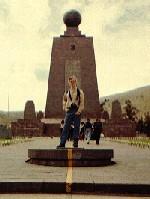Ecuadorian Highlands (Sierra)
| Baños | Cuenca | Quito |
|
Ecuador does not have its own currency. In 2000, the country gave up the surce for the US dollar. It probably halted inflation but it seems to have increased the cost of basics. Its still cheap by North American or Western European standards but Ecuador is more expensive than Peru. A good restaurant meal might cost about $US3 in Peru but about $US5 in Ecuador. Still a bargain.
None of Air Canada's partner airlines actually fly into Ecuador so we did not have the most direct route to Ecuador, the trials and tribulations of flying on reward points. For a very small country, Ecuador has plenty of things to see from the Amazon jungle, the Andean Highlands, and the tropical coast PLUS the Galápagos Islands. |
Our original plan was to fly into Lima, Peru then make our way overland toward Ecuador seeing the sites of Northern Peru. Reports of flooding in Northern Peru and coastal Ecuador and strikes at the Ecuador border resulted in a change of plans. After spending 4 days visiting parts of Northern Peru we took the overnight bus from Trujillo to Lima, then flew with AeroContinente to Quito via Guayaquil. Guayaquil is Ecuador largest city and main port. Although we have no plans to spend any time in Guayaquil, we will stop at the airport four times. The approach to the runway passes over a very wide river, looking out the window I was thinking "Pavement, where's the pavement?".
As soon as we arrived in Quito, our plan was to leave. It was late afternoon when we arrived and the last flight for Cuenca had already left so we got a taxi ($US5) to the bus terminal for a bus ($US3.10) to the resort town of Baños. Yep, a half hour taxi ride cost more than a 3.5 hours bus ride. The main difference between New York cabbies and Quito cabbies is even fewer Quito cabbies speak English.
Baños
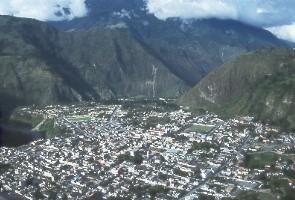
Our first taste that Ecuador was a poorer country than Peru was at the Quito bus station. The buses were not in as good shape as those in Peru. Baños was about 3.5 hours from Quito for only $US3.10 for 2 people. Although the bus was supposedly an express bus I think express must have a different meaning in Ecuador. The bus stopped for anyone. We were the only people on the bus when it left the bus station but within a half-hour it was full.
Baños is a resort town in a beautiful setting with hiking trails, hot springs, an important religious shrine, a sub-tropical climate, and overlooking it all an active volcano that last erupted in 1999. We arrived at about 8:30 at night with not a single taxi at the bus station. This is the first time I've ever arrived at a bus station and not have to practical beat off the taxi drivers with a stick, they can be a bit aggressive sometimes. Its surprising how even a small
unfamiliar town can be scary at night. My wife was sure we were going to be robbed. We stopped at a nearby restaurant to ask about the lack of taxi. The waitress kept telling us there were cabs at the bus station. We next dropped into a tour operator that was open at 8:30 on a Sunday. Apparently on Sunday night the taxi drivers in Baños have a get together. The person at the tour agency called a taxi friend and we ended up sharing a cab with the driver, his wife and child. Not a great introduction but people seemed friendly. We decided to treat
ourselves and stayed at the Sangay Hotel, the most expensive in town ($US21) which overlooked one the hot springs and a huge waterfall, the Cascada Cabellera de la Virgen
(Virgin's Hair Waterfall). The taxi driver keep telling us very nice but very expensive. A great breakfast spread was included in the price, in fact most hotels in South America include breakfast.
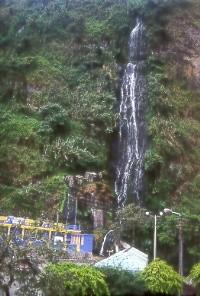
We were awaken at about 6:00 am to the sounds from the hot springs. This close to the equator the days and nights are of even length with no lingering dawn or dusk and people get an early start to their day.
After breakfast, our usually routine when in a new community is to visit the main square. In Baños the main square contains an important religious shrine, Iglesia de Nuestra Señora del Aqua Santa (Church of Our Lady of the Holy Water). There are many vendors outside the church selling candles and rosaries and nearby is a pedestrian strip were the sounds of the slap of toffee stretchers can be heard. This was the first church we visited in Ecuador and we noticed something that seemed strange but noticed later in other churches. In Ecuador they seem to surround their religious icons with neon and/or Xmas lights. I thought it looked tacky but as my dad says "If it wasn't for bad taste, some people would have no taste at all". If the paintings in the church are any indications there must have been a volcano eruption and/or earthquake ever other day during the 18th to early 19th which the statue of the Virgin stopped.
For lovers of outdoor activities there is plenty to do in Baños; lots of hiking trails, mountain biking, rafting, kayaking, horseback riding and after a hard day of activity several hot springs to relax although only one is open after dark. Baños is also used as a gateway into the Amazon and nearby is Sangay National Park with its outstanding natural beauty and two active volcanoes.
From Baños it is a 2 hour bus ride to Riobamba where we got caught another bus to get to Cuenca which is a 6.5 hour bus ride. On the road from
Baños we passed through Ambato which has some unusual statues. We were also introduced to an unusual method of street selling. Street vendors would get on the bus and make presentations about the products they were selling along with telling their life stories. A harsh way to make a living.
Cuenca
After an 8 hour road trip from Baños via Riobamba we arrived at Cuenca which probably has the nicest bus station in Ecuador. Along the way we passed through Alausí which is famous as the railroad stop nearest the Nariz del Diablo (Devil's Nose), which is supposedly an amazing feat of railroad engineering.
Cuenca is Ecuador's third largest city, a beautiful colonial city full of cobblestone streets, plazas, and churches. Many people come here to learn Spanish. Our first full day in Cuenca was May 1 (May Day) and many businesses, including restaurants, were closed. We had a hard time finding an open restaurant for lunch. There were May Day marches and riot police in full gear were out in force in case something happened.
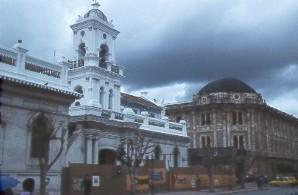
Tall palms and taller pines fill the main square in Cuenca, Parque Calderón. There are two cathedrals; Catedral Antigo (Old Cathedral) build with stones from the Inca palace of Pumapungo now closed for renovations and the massive Catedral Nuevo (New Cathedral) started in 1880 and still unfinished due to an "architectural miscalculation". Highly original names. The tourism literature claims there is a church for every Sunday in Cuenca, although I did not try counting but it can't be far off.
Although a beautiful city many locals seem strangely proud of a new structure in the newer section of the city on the other side of the Rio Tomebamba, the Millennium Project. Basically it was a shopping mall with movie theatres, shops, and fast food outlets, a taste of the first world in the third world. Near the Millennium Project there is the Museo del Banco Central which has an excellent archaeological collection and is near the Inca ruins of Pumapungo. For fans of the macabre there is the Museo de la Historia de la Medicina (Medical History Museum), a stark collection of old medical equipment including preserved corpses. It was almost surreal.
A couple of days in Cuenca and we were heading back to Quito, choices were 10 hours on the bus or 40 minutes in the air. TAME, the national airline was booked for the trip so we went with Icaro Express, a small operation flying a 19 seat Beechcraft. My wife called it Wings Airline but it was better than 10 hours on the road. We soon arrived in Quito or as I soon start calling it, Gringoland.
Quito
Quito is the capital of Ecuador and at 2,800m above sea level might pose problems for people who suffer from altitude sickness. The city is generally divided into three areas; New Town which contains the tourism infrastructure, Old Town which contains all the interesting sites like churches, plazas and government palaces, and everywhere else.
New Town should also be called Gringoland. Every third building seems to be a restaurant, travel
agency (often selling last minute Galápagos deals), or a cybercafe. Menus are often in English. There is where the nightlife is and probably where you should spend the night since rumor says that Old Town is not safe after dark.
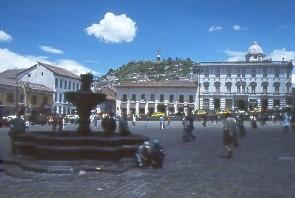
Old Town, also called Colonial Quito, is a World Heritage site and a well deserved one with plenty of churches, spacious plazas and 300 year old buildings. There are plenty of sites to see including the Plaza De La Independencies (Plaza Grande) which includes the Palacio Presidencial and a colossal cathedral which is the resting place of Independence hero Antonio José de Sucre, Plaza Santo Domingo and its church Iglesia de Santo Domingo, Plaza San Francisco and its Monasterio de San Francisco, and a bit further away the gothic Basilica with climbable spires that offer great views of the city.
From almost anywhere in Old Quito you will notice La Virgen de Quito which is a statue which surveys the city from the summit of El Panecillo. Trips up the stairs can be dangerous, even groups get mugged. We meet two former Israeli soldiers who got mugged, when people who live in the neighbour warn you its a good idea to avoid the area.
We got a rare site on our day in Old Quito, the president of Bolivia was on a state visit and we saw both the president of Ecuador and Bolivia tour the Cathedral. As you can imagine security was tight.
Old Town is only a electric trolley ride from New Town. There are only a few restaurants but prices are geared toward locals so its cheap eating. There are plenty of other churches, museums and other attractions to visit. Between Old and New Town visit the modern Museo Arqueológico/Etnología of the Banco Central. Displays are
labeled in both English and Spanish.

Old Quito is a site in itself but if you have the time there are sites worth visiting near Quito. Markets town, hiking
volcanoes, and cloud forests are all options but since Quito is only 18 kilometres south of the equator many people make the journey. The pink and white city buses
labeled Mitad del Mundo will take you to the equator for $US0.35, you might have to share your ride with livestock, it really can be a chicken bus. Its tacky and touristy but some sites have to be visited, the massive equator monument has an excellent ethnographic museum on Ecuador's indigenous cultures. There is also a monument, Heros del Cenepa, dedicated to the soldiers of the 1995 border dispute with Peru.
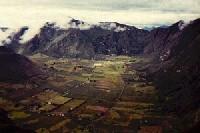 Five kilometres north of the equator is located Pululahua Crater which offers hiking trails around the rim of the extinct volcano where you can see the farmland which how covers the bottom of the crater. The trail can be hazardous and a guide will only cost you about $US8 for about 4 hours. In 1978 it was declared a protected reserve and is
supposedly South American's largest crater.
Five kilometres north of the equator is located Pululahua Crater which offers hiking trails around the rim of the extinct volcano where you can see the farmland which how covers the bottom of the crater. The trail can be hazardous and a guide will only cost you about $US8 for about 4 hours. In 1978 it was declared a protected reserve and is
supposedly South American's largest crater.
For a small country there is plenty to see in Ecuador and we did not even get to the coast or the Amazon jungle and we certainly could have spend more time in the Highlands (Sierra).
| Visit Galápagos Islands | Return to Travel Page | Return to Main Page |
